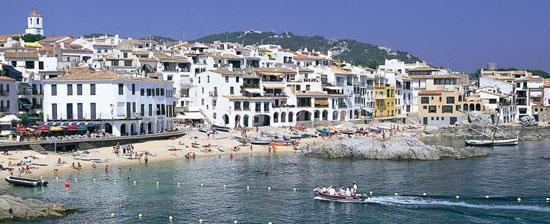Comarca Baix Empordà Demonym(s) Palafrugellenc Area 26.9 km² Local time Tuesday 3:43 AM | Elevation 64 m (210 ft) Website palafrugell.cat Population 22,763 (2014) | |
 | ||
Weather 12°C, Wind NW at 0 km/h, 72% Humidity Points of interest Castillo de Cap Roig, Far de Sant Sebastià, Museo del Corcho de Palafrugell, Cala Aigua‑Xelida, Cala El Golfet | ||
Palafrugell costa brava spain
Palafrugell ([pəɫəfruˈʒeʎ]) is a municipality in the Mediterranean Costa Brava, located near Palamós in the comarca of Baix Empordà, in the province of Girona, Catalonia, Spain. With 22,365 inhabitants it is the largest city of its comarca. Several coastal and interior towns (Llafranc, Calella de Palafrugell, Tamariu and Llofriu) belong to this city.
Contents
Map of Palafrugell, Province of Girona, Spain
The combination of a good summer climate and beautiful beaches has been exploited for both domestic and international tourism. Tourists have come from a wide range of countries, especially the Netherlands, England, France, and more recently, the United States. It also serves as a summer holiday town for residents of cities such as Barcelona and Girona.
This medieval town was once fortified but is no longer. Many narrow streets emanate from Plaça Nova -a large square with bars, restaurants and boutiques. The local government (Ajuntament) sponsors activities such as concerts and dances including the traditional Sardana. St. Martí's church was built in the late 11th century and is close to Plaça Nova.
There is a new bus station belonging to Grup SARBUS whose local division is known as Sarfa. The station has a regular bus service, servicing the Costa Brava region (including Llafranc, Calella de Palafrugell, and Tamariu) as well as Barcelona.
Palafrugell was reputed for its cork manufacturing in the 18th and 19th centuries. The largest factory was owned by the American company Armstrong and employed hundreds of locals. Its closing in the 1970s led to severe unemployment. The factory's tower still stands, and there is now a small museum commemorating the cork industry just below it.
